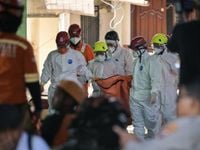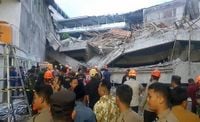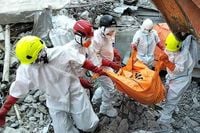On September 29, 2025, the tranquil afternoon at the Al Khoziny Islamic boarding school in Sidoarjo, East Java, was shattered by a sudden and catastrophic collapse. Hundreds of students, most of them boys aged between 12 and 19, had gathered in the ground-floor prayer hall for afternoon prayers when the multi-story building gave way, plunging them into chaos and tragedy. By October 6, the death toll had risen to at least 63, making it Indonesia’s deadliest disaster so far this year, according to the national search-and-rescue agency and multiple news outlets including Reuters and BBC.
Rescue workers, clad in bright orange vests and helmets, worked tirelessly for over a week, sifting through the tangled wreckage of concrete and steel. The grim task transitioned from a race to save lives to the painstaking recovery of bodies. As Kurdistan24 reported, by the eighth day of operations, 54 bodies had been found, with hopes fading for any further survivors. The National Search and Rescue Agency (Basarnas) confirmed that the focus had shifted to providing closure for grieving families, aiming to complete the recovery and return the victims for burial as soon as possible.
"The latest update was at 3:34 a.m. when we found one more body, bringing the total to 54, including five body parts. This means the number of complete bodies recovered is 49," said Basarnas Operations Director Yudhi Bramantyo on Monday, as quoted by the Indonesian national news agency ANTARA. He added, "We hope we can conclude the recovery today, and we will return the bodies [to the families]." The search was particularly focused on the south side of the collapsed building, where mapping had indicated at least four more victims remained trapped.
The collapse occurred as construction crews were placing concrete for a new upper floor, part of a vertical expansion of the two-story structure. According to the East Java Police and Indonesia’s National Disaster Mitigation Agency (BNPB), the building’s columns and foundations were simply not designed to bear the added loads from the ongoing expansion. "Preliminary evidence shows the columns and footings could not support the new load path," a BNPB spokesperson explained to ENR. The timing of the disaster was especially cruel: the prayers had drawn the students together just as the structure was at its most vulnerable.
Survivors described harrowing escapes. Muhammad Rijalul Qoib, a 13-year-old student, recounted to Detik News, "I heard the sound of falling rocks, which got louder and louder." He ran for the door, narrowly escaping, but was still wounded by falling debris. Such testimonies have brought the human cost of the tragedy into sharp relief for the Indonesian public.
The disaster has highlighted longstanding problems with construction oversight and regulation in Indonesia, particularly in the country’s vast network of Islamic boarding schools, or pesantren. According to Indonesia’s Ministry of Religious Affairs, there are approximately 42,000 such schools serving seven million students nationwide. However, Public Works Minister Dody Hanggodo told local media that only 50 pesantren buildings have proper permits. Many, like Al Khoziny, are built incrementally, often without formal engineering review or adequate safety checks.
“This appears to be a classic case of overloading an unverified frame,” a civil engineering lecturer from the Bandung Institute of Technology told local press. “When columns and foundations are designed only for original occupancy, adding floors without recalculating axial and shear capacity is courting failure.” The Public Works and Housing Ministry (PUPR) has dispatched a forensic team to the site, and officials say the findings will inform revisions to Indonesia’s building-code compliance procedures later this year.
Complicating the rescue effort was a magnitude-6.0 earthquake that struck the Java Sea on September 30, about 150 kilometers from the school. While authorities were careful not to link the seismic event directly to the collapse, the earthquake destabilized the rubble, making the already dangerous search and recovery operation even more precarious, as reported by Indonesia’s Meteorology, Climatology and Geophysics Agency.
Indonesia’s pattern of unpermitted and informally supervised construction is not new. Fewer than 20% of private and institutional buildings outside Jakarta hold valid permits, according to a 2023 report from PUPR. The tragedy at Al Khoziny is not an isolated incident: just last month, a similar building collapse during a prayer recital in West Java killed three people and injured dozens more. These repeated disasters underscore the urgent need for systemic reform in construction safety and regulatory enforcement.
Religious Affairs Minister Yaqut Cholil Qoumas has ordered immediate inspections of similar multi-story facilities across East Java and pledged tighter oversight of privately funded school projects. The national police have also deployed disaster victim identification teams to gather DNA samples and dental records, ensuring that families receive definitive answers about their loved ones. The government’s response, while swift, has been met with both grief and frustration from the public, with many calling for lasting change to prevent future tragedies.
As the dust settles in Sidoarjo, the community is left to mourn not just the loss of life, but also the sense of security that such places of learning and prayer are meant to provide. The collapse of Al Khoziny Islamic boarding school stands as a somber reminder of the deadly consequences that can arise from lapses in oversight, rushed construction, and the absence of rigorous safety standards. For the families who have lost children, and for a nation that has witnessed too many such tragedies, the hope is that this disaster will finally prompt meaningful reforms—ensuring that Indonesia’s schools are safe havens, not sites of preventable catastrophe.






